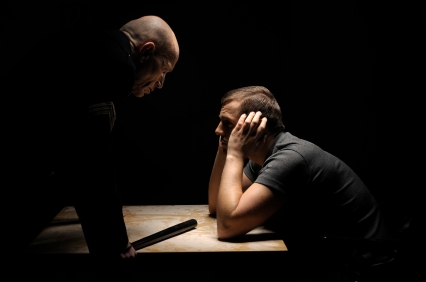 A man is arrested for the rape of his daughter over a nine-year period of time. He is taken into an interrogation room at six p.m., he is told he can freely leave but then not allowed to exit, he may or may not know that he should contact an attorney, and somewhere around nine hours later he confessions to something short of raping his daughter, but nevertheless incriminating enough to be arrested and convicted.
A man is arrested for the rape of his daughter over a nine-year period of time. He is taken into an interrogation room at six p.m., he is told he can freely leave but then not allowed to exit, he may or may not know that he should contact an attorney, and somewhere around nine hours later he confessions to something short of raping his daughter, but nevertheless incriminating enough to be arrested and convicted.
The question before us is whether this was a legitimate confession and whether we should be doing more than we have already to prevent false confessions, which lead to long imprisonment for innocent individuals.
That should be an alarming figure, because only a small percentage of cases even have DNA evidence in which people can be exonerated.
As we approach a hearing on the Bennie Moses case, already nearly two months after his conviction on over 60 counts for the rape of his daughter, I am still troubled by the circumstances of his confession, the length of the interrogation, the lack of honesty by the police, the lack of honesty about whether he was free to go, and the overall lack of protocols and safeguards to ensure that an innocent individual will not falsely confess.
In fact, we may be going the other way. There was an interesting discussion of Miranda by Law Professor Tamar Birckhead, whose op-ed appeared recently in the Los Angeles Times.
Professor Birckhead described the oral argument in the US Supreme Court in late March, involving the case of J.D.B. vs. North Carolina.
Professor Birckhead, an assistant professor of law at the University of North Carolina at Chapel Hill, wrote, “During oral argument before the U.S. Supreme Court in late March in the case of J.D.B. vs. North Carolina, Justice Stephen G. Breyer posed the following question with no small degree of sarcasm: “And what is the terrible thing, the awful thing that has to happen if the officer isn’t sure whether this individual thinks he’s in custody or not? Suppose the officer just isn’t sure. What terrible thing happens?” She then answered her own question: “The terrible thing that happens is you have to give them a Miranda warning.””
But Justice Antonin Scalia had a different take, arguing, “We don’t want Miranda warnings to be given where they are unnecessary because they are only necessary to prevent coercion, and where there’s no coercion, we want confessions, don’t we?” To emphasize his point, he added, “It’s a good thing to have the bad guys confess that they’re bad guys, right?”
The professor went on to point out that this case is merely the latest in a string of cases that addresses a core issue: “When and under what circumstances police must advise suspects that they can refuse to answer questions and consult with a lawyer?”
She wrote, “Implicit in Breyer’s remarks is the recognition that this so-called warning has a negligible effect on most interrogations. Explicit in Scalia’s retort is a resistance to giving criminal suspects any perceived advantage during an investigation.”
She adds, “Generally, neither side probes much deeper than that, but they should.”
The subject in this is a 13-year-old middle school student who was questioned by the police regarding local break-ins.
Professor Birckhead wrote, “[To] the juvenile court judge and the North Carolina appellate courts, the boy had no right to be told that he could remain silent and have a lawyer because he was not “in custody”; only custodial interrogation triggers the duty to give the warning, as established by Miranda vs. Arizona in 1966.”
“The open question before the Supreme Court now is whether J.D.B.’s youth should be considered when determining whether a “reasonable person” would have felt free to leave, the applicable test for whether questioning was custodial,” the Professor continued.
Social science research suggests that neither youths nor adults possess much understanding of either the language or the significance of Miranda warnings. Moreover, even when they do understand the warnings, they are not deterred from confessing.
Wrote the Professor, “Empirical data have demonstrated that Miranda warnings fail to counteract the pressures inherent in a custodial interrogation. Because police officers continue to use coercive techniques and practices when questioning suspects, Miranda warnings are ineffectual in lowering the risk of false confessions.”
The data on false confessions is alarming.
The New York Times ran an article, “Confessing to Crime, but Innocent.” In it they highlight the case of Eddie Lowery, who spent ten years in prison for a crime that he did not commit. The only evidence to tie him to a rape was a confession.
The Times reported, “At trial, the jury heard details that prosecutors insisted only the rapist could have known, including the fact that the rapist hit the 75-year-old victim in the head with the handle of a silver table knife he found in the house. DNA evidence would later show that another man committed the crime.”
“I beat myself up a lot” about having confessed, Mr. Lowery told the Times in a recent interview. “I thought I was the only dummy who did that.”
The Times reported that at least 40 others have confessed since 1976, where DNA evidence has later shown the confessions to be be false, according to research by Grandon Garrett, a law professor at the University of Virginia.
Professor Garrett has an article that demonstrates how various incriminating facts can get into confessions, leading the police and prosecutors to conclude that the individual knew facts only the individual at the crime scene could know. Often the police were the ones who introduced these facts. Sometimes they were unintentional, other times they appear intentional. Sometimes, they even introduced facts that turned out to be false, and they still were not caught.
Professor Garrett writes, “Scholars increasingly examine the psychological techniques that can cause people to falsely confess, and [they] document instances of known false confessions. This article takes a different approach, by examining the substance of false confessions, including what was said during interrogations and how the confession statements were then litigated at trial and postconviction. Doing so sheds light on the phenomenon of confession contamination. Not only can innocent people falsely confess, but all except two of the exonerees studied were induced to deliver false confessions with surprisingly rich, detailed, and accurate information.”
“We now know that those details could not have likely originated with these innocent people, but rather must have been disclosed to them, most likely during the interrogation process,” the Professor continues. “However, our constitutional criminal procedure does not regulate the postadmission interrogation process, nor do courts evaluate the reliability of confessions.”
The case of Bennie Moses also demonstrates the problem, with merely about having a jury examination. Most jurors have no perspective with which to situate themselves in a confession.
So we are stuck with a viewpoint embodied by the husband of a juror.
The juror had asked her husband “whether he could ever be coerced to admitting that he slept with their daughter if he did not do so.”
The juror’s husband naturally responded no, he would never admit to sleeping with his daughter if he did not do so, no matter what.
But the research shows otherwise. Moreover, the juror would apparently have little way to discern a legitimate confession from a false one.
Professor Garrett told the NY Times he was surprised by the complexity of the confessions he studied. “I expected, and think people intuitively think, that a false confession would look flimsy,” like someone saying simply, “I did it,” he said.
Instead, he said, “Almost all of these confessions looked uncannily reliable,” rich in telling detail that almost inevitably had to come from the police. “I had known that in a couple of these cases, contamination could have occurred,” he said, using a term used in police circles for introducing facts into the interrogation process. “I didn’t expect to see that almost all of them had been contaminated.”
At the time I suggested that perhaps we ought to require lawyers to be present if we wish to take someone’s confession. My thought was that we should not be trying to trick or coerce someone into admitting guilt. If they truly wished to do so, they should do so with the full benefit of counsel being present.
Clearly, that view would not sit well with Justice Scalia,who is concerned only about bad guys admitting guilt.
Professor Birckhead suggests that this remains a vexing problem. She wrote, “We as a society must begin a more honest dialogue regarding how best to protect suspects’ constitutional rights while not hampering the reasonable investigative techniques of law enforcement. We all benefit when criminal charges are brought against the person who actually committed the crime instead of merely making a quick arrest to appease the public and close the case.”
She adds, “As Breyer asserted, there is little harm in giving Miranda warnings when it is unclear whether a suspect feels free to leave, as often occurs during the questioning of youth, as in J.D.B. vs. North Carolina.”
However, for her as for others, that is the minimum requirement. she wrote, “A simplified version of the warning for young suspects and consultation with a trusted adult is an apt place to start, which some police departments have begun to explore. Another option is mandating the video recording of police interviews with suspects, which several states have done. In fact, in jurisdictions where video recording has been implemented, law enforcement has consistently reported that it has had no negative effects on the investigative process. A third proposal would place time limits on police questioning to prevent repeated or protracted and potentially coercive sessions. A further improvement would be to ban the use of lying, trickery and false promises of assistance or leniency by law enforcement during interrogation.”
The problem, though, gets back to Professor Garrett’s study on false confessions – they look “uncannily reliable.” So videotaping is not even an answer, let alone a panacea.
In two weeks, Judge Mock will be dealing with a lot of these issues. He seems unlikely to rule for the need for a new trial. The appellate court, though, is likely to look at this issue with a good deal more trepidation.
Until we have a consensus, though, on Miranda, we are certainly not going to make a dent in false confessions.
—David M. Greenwald reporting





I think an important point to add is that most people think of these “suspects” as criminals and so they don’t care how they are treated. The truth is that if you are innocent and brought in for questioning the “suspect” is no different than you and I. Try to put yourself in the shoes of an innocent person being interrogated – realize it can easily be you or I there. I think this is the most critical and most difficult thing for us as regular law abiding citizens can do. But it is crucial that we try.
Regarding video taping – I’m for video taping the interrogation, but I think it should be required that the entire interview without edits be played for the jury. In the Moses situation the jury saw, I think you said, 45 minutes of a 9 hour interview. Yes I know it would take a lot of court time, but when you are talking about taking someone’s liberty away from them for the rest of their life – 9 hours is nothing. It is the only way to at least try to understand fully what happened.
Good points lyah. Another problem with the Moses trial was that first the defense attorney had to fight to show more than the six minute confession portion of the video. Second, the judge had discretion to edit what was scene. Third, they did not show the part where he asked to leave and was told he could, then told to hold on, then told he couldn’t leave. Fourth, they did not show the long pauses where the individual was made to wait, and tire. So yes there is a video of it, but the jurors lack the expertise to evaluate it and the context for which the statements were made.
David, thank you for elaborating. I agree that none of us until we are put in that situation can understand how it feels and how a false confession might be given. And the Innocence Project has proved that false confessions happen without a doubt. I meant that I believe in the minimum the Judge should have allowed the full recording with out edits to be viewed by the jury. This is really the only appropriate thing – if a confession is allowed in front of the jury than the whole thing should be seen. Then they could have seen everything you’ve talked about. However, I agree this doesn’t mean they jury has the expertise to properly evaluate interrogations, but at least they might have a better understanding of what happened, instead of what they were given.
Was he waterboarded?
From APA.org (American Psychological Association):
[quote]Kassin’s article suggests that videotaping could help judges and juries understand the context in which promises or threats were made and whether a confession’s details grew out of interrogators’ questions. And videotaping could also help deter police from conducting prolonged interrogations, like Ochoa’s two-day interrogation, since research suggests that 73 percent of false confessions are given after more than six hours of interrogation.
“Psychologists need to help police develop a set of techniques to catch criminals and leave innocent suspects unharmed,” he says. “We need to build a better mousetrap.”[/quote]
Videotaping is a start, but even seasoned observers failed to catch problems in confessions. I fear that the videotape could be looked at as a panacea. But I like the idea of police working with experts to develop a better protocol for interrogating subjects to catch criminals but not innocents.
[quote]Videotaping is a start, but even seasoned observers failed to catch problems in confessions. I fear that the videotape could be looked at as a panacea. But I like the idea of police working with experts to develop a better protocol for interrogating subjects to catch criminals but not innocents.[/quote]
I tend to agree w you. For instance, length of interrogation is important. A two day interrogation? Come on… law enforcement could probably wear anyone down into confessing in two days… Another issue is whether the defendant is really “free to leave”. Monica Lewinsky certainly didn’t believe she was free to leave the hotel room that 15 or so FBI agents took her to so she could be questioned. Yet later, when Kenneth Starr was questioned about the “interrogation”, he disingenuously claimed she had not been under arrest, and therefore was not interrogated, and therefore was “free to leave” at any time. That whopper didn’t pass the laugh test…
That’s a good point because police perceptions about consensual stops and questioning differ from that of the ordinary citizens. I found myself in a situation like that during the course of my duties for the Vanguard when a police officer asked to see my ID. It was only after the fact that I regretfully realized I probably did not have to give it to him. But I was not doing anything wrong so I didn’t the caution necessary. It could have been a huge mistake. People who believe they have nothing to hide let their guard down and in creeps things they did not account for.